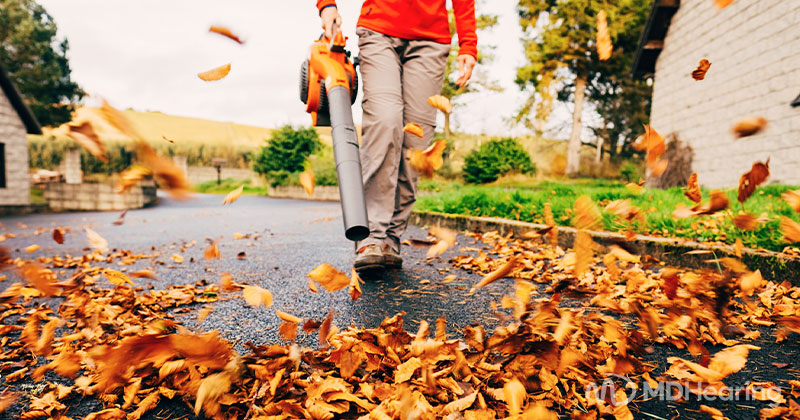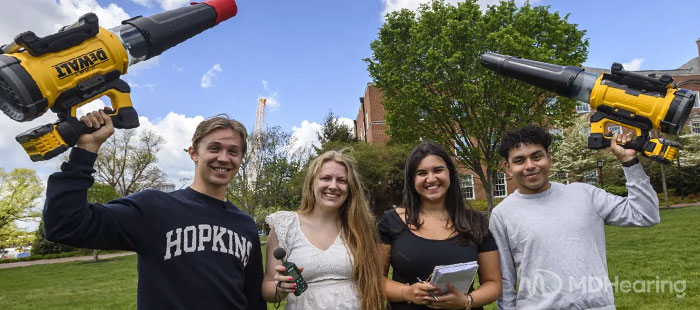As summer passes into fall, we’re gearing up for all of the familiar delights of autumn, from trees changing colors to pumpkin spice lattes. One thing that won’t be so welcome, however, is the noise of leaf blowers filling the air.
Leaf blowers have their benefits, of course: they’re much more efficient than raking and require less physical effort, which makes it easier for people of all ages to keep their yards clear of debris. Perhaps their biggest disadvantage, though, is the loud, high-pitched buzzing sound they produce.
How Loud Are Leaf Blowers?
Hundreds of cities and counties across the United States have enacted ordinances that limit or even ban the use of leaf blowers in an effort to reduce noise pollution. One study found that gas-powered leaf blowers exceeded 100 decibels (dB) at the source, and also exceeded 55 dB from 800 feet away—which is beyond the World Health Organization’s recommended limits. While electric leaf blowers are quieter than gas-powered ones, both for the user and for those around you, they can still be irritatingly loud.
Wall Street Journal editor Kris Frieswick explores the phenomenon of why leaf blowers are uniquely obnoxious in her article “Here’s Why Leaf Blowers Are Evil Incarnate.” She writes that “no other suburban noisemaker has the ability to infuriate as quickly and thoroughly as a leaf blower can,” comparing the sound to a “mosquito attached to the world’s largest megaphone”.
A Quieter Leaf Blower From Johns Hopkins Students
That’s why we were so excited to read the news of four undergraduates at Johns Hopkins University who invented a quieter leaf blower. Mechanical engineering students Michael Chacon, Andrew Palacio, Leen Alfaoury, and Madison Morrison spent months studying an electric leaf blower piece by piece. They took it apart and analyzed it to understand how it produced sound and how this sound could be lowered.
According to team member Palacio, the noise from a leaf blower is “very complicated” and “contains a lot of different frequencies,” like many notes playing simultaneously on a piano—which made it difficult to know how to reduce it. The students spent months working on more than 40 different versions before arriving at their end result.
The final product consists of an attachment at the end of the leaf blower’s pipe, like a muffler on a car. This attachment splits up the incoming airflow and separates it as it passes through, shifting and dampening part of the noise. According to Chacon, however, the attachment doesn’t reduce the force of the air—so the machine is still just as powerful as before.
Specifically, the students’ innovation limits “the most shrill and annoying frequencies” by 12 decibels, which makes them 94 percent quieter. (Remember, the decibel scale is logarithmic, which means that a noise 10 decibels higher actually sounds 100 times louder.) The design also limits the total noise of the leaf blower by two decibels, which makes it 37 percent quieter.
Image Source: fortune.com
Morrison describes the effect of their changes as “the difference between hearing a high-pitched whistle and hearing what you might think of as wind noise.” Interested in hearing the before and after for yourself? Check out this YouTube video to see the students’ quieter leaf blower in action.
What’s more, the new and improved leaf blower might be available on shelves within two years. A senior product manager at Stanley Black & Decker has called the students’ design “ready to be mass manufactured” and “a really rare and dramatic level of success”. The attachment is already patent pending, and the students believe it could even be used for other appliances such as vacuum cleaners and hair dryers.
Leaf Blowers and Hearing Loss
Assuming it reaches the market, the students’ invention should be a breakthrough in helping reduce noise-induced hearing loss, which is the third most common chronic health condition in the U.S. Not only do leaf blowers disturb the peace, they also present a hazard for sensorineural hearing loss, which occurs when the tiny hair cells in your ear are damaged over time (often as a result of loud noises).
The National Institutes of Health (NIH) writes: “Harmful noises at home may come from sources including lawnmowers, leaf blowers, and woodworking tools.” In fact, household tools and appliances are one of the most surprising causes of hearing loss.
The U.S. Centers for Disease Control and Prevention (CDC) also specifically highlights leaf blowers as a danger to hearing. According to the CDC, leaf blowers expose users to noise levels of around 90 decibels. This is beyond the level of 85 decibels at which prolonged exposure can result in hearing damage. Even from 50 feet away, the sound of a leaf blower can reach 77 to 80 decibels—just under the hearing loss threshold.
Protect Your Hearing
Just two hours of using a leaf blower uninterrupted without ear protection may cause permanent damage to your ears. That’s why you should always wear earplugs or earmuffs when using a leaf blower and take frequent breaks to avoid going over this dangerous limit.
If you think you may have hearing loss, it’s best to take a hearing test and address any hearing loss early on. Our free online hearing test can be completed from the comfort of home, only takes 8 minutes, and you get immediate results.
If you’re already experiencing hearing loss, MDHearing can help. We offer affordable, high-quality, FDA-registered hearing aids that treat mild to moderate hearing loss. Our team of audiologists and licensed hearing professionals has decades of experience in the field and is ready to assist with any questions or issues when using your hearing aids.
Interested in starting a risk-free trial? Browse our affordable hearing aid options today.
BROWSE HEARING AIDS

